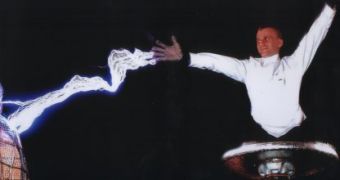The United States, Russia, India, Japan and China have all announced plans to send astronauts back to the Moon around 2020.
Among many problems that such a mission will have to deal with, there's one which is less expected, as it comes from Earth itself.
Once in every orbit around the Earth the Moon moves through the magnetic tail - the region of space on the night side of the Earth where the magnetic field is drawn out into a million or more kilometer-long tail pointing away from the Sun. In the middle of the tail there is a region full of energetic electrons and other charged particles (the plasma sheet). When the Moon passes through the plasma sheet these electrons can collect on parts of the lunar surface and charge them with static electricity. Observations from NASA's Lunar Prospector spacecraft during 1998 confirm the existence of this charging.
A British scientist, Dr. Mike Hapgood of the Rutherford Appleton Laboratory, will present evidence of the Earth's magnetic field being a hazard to future explorers of the moon, and that this charging may increase after the year 2012 and become an important issue for future lunar explorers.
Dr Hapgood suggests that the exposure of the Moon to plasma sheet charging varies markedly over an 18-year cycle linked to changes in the Moon's orbit.
Lunar surface charging may be an important issue for future lunar exploration because it increases the risk of electric discharges, which can interfere with and damage sensitive electronics. It may also affect the behavior of lunar dust, which is a recognized hazard for lunar astronauts as it can easily enter spacesuits, living quarters and equipment.
"Electrical charging is one of the less well-known natural hazards of space flight. It's important to understand it how this affects the Moon so spacecraft designers can use scientific knowledge to protect future explorers," Hapgood said.
He claims that this exposure was low at the time of the Apollo landings in the early 1970s and is low again today. But, it was high in the 1990s and will rise again after 2012, he adds.
All the planned manned missions to the Moon are expected to take place around the time when the static charging will be at its peak, so it seems that scientists did not take into account the fact that all astronauts, Caucasians, Asians and Indians alike will face the same "shocking" problem.

 14 DAY TRIAL //
14 DAY TRIAL //